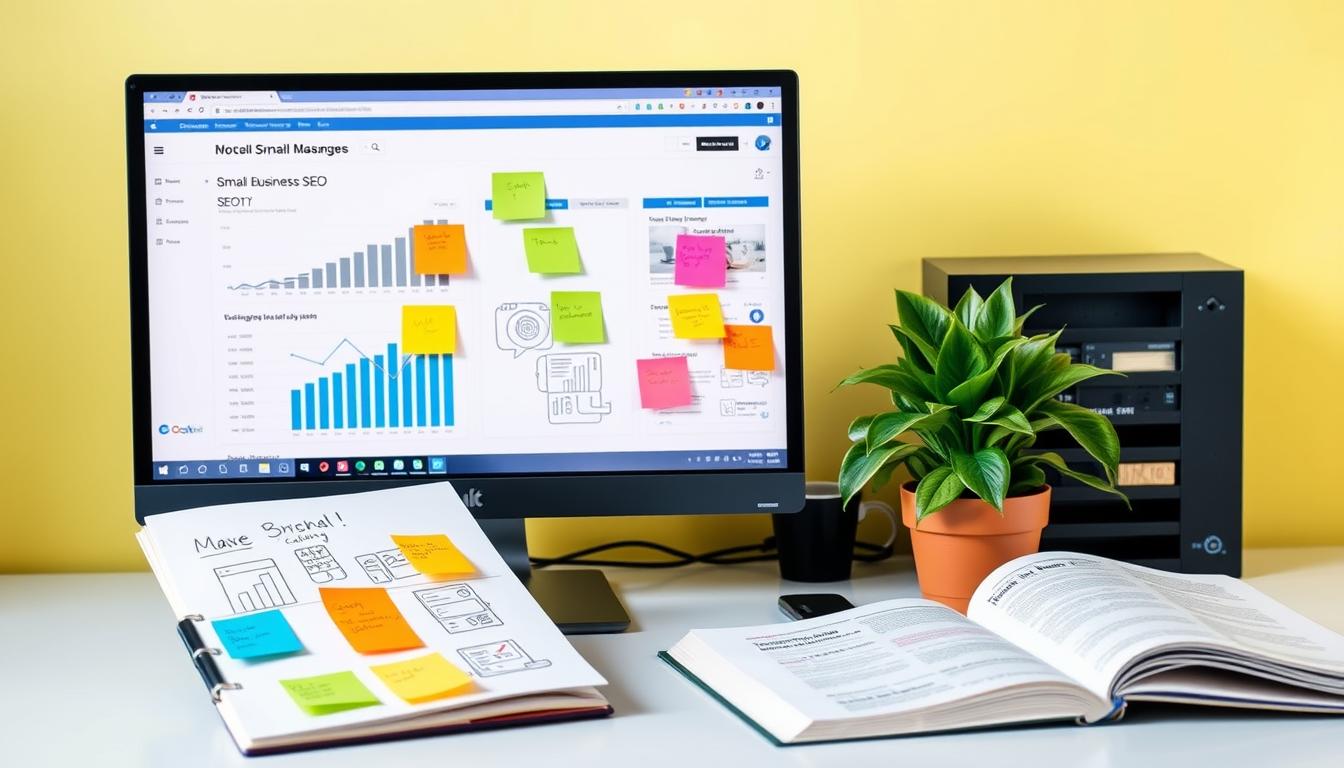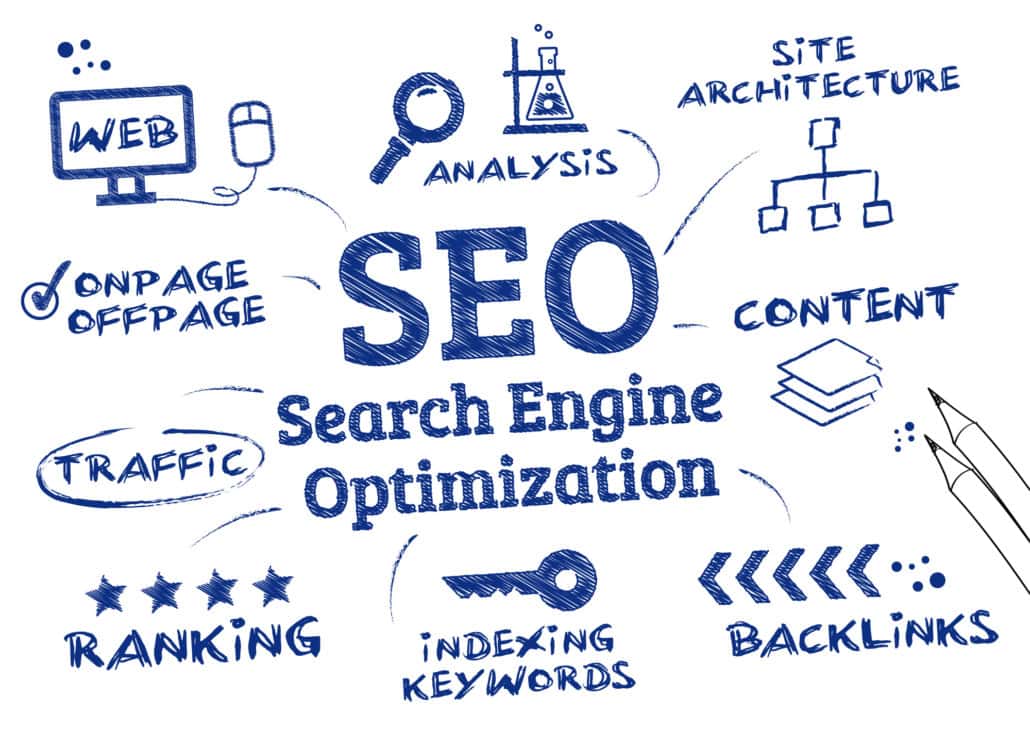Best SEO Practices for Small Websites 2025

[et_pb_section admin_label=”section”]
[et_pb_row admin_label=”row”]
[et_pb_column type=”4_4″][et_pb_text admin_label=”Text”]By 2025, a remarkable 75% of small businesses will use SEO platforms to boost rankings and get more website visitors. Knowing the best SEO strategies is key to success in the online world. Good website SEO techniques make you stand out. This article gives you practical strategies for small businesses to improve their web presence.
Key Takeaways
- Comprehensive SEO tools are vital for improving online visibility.
- Keyword research aids in targeting the right audience for your niche.
- On-page optimization can significantly enhance your search rankings.
- Utilizing local SEO strategies can increase foot traffic and conversions.
- Regular content updates foster audience engagement and retention.
Understanding the Importance of SEO for Small Websites
Small websites face tough competition where being seen is key to success. Knowing how SEO helps small sites can boost your online presence. Organic searches are a top way to get traffic, so competing well is crucial.
SEO builds trust by making your site rank higher. Customers tend to trust these sites more, leading to more interaction and sales. Small websites that work on their SEO can get more traffic naturally. This is often more lasting than using ads.
SEO is also about making sites that people enjoy using. A site that’s easy to use pulls in visitors and can hold their attention. This helps turn visitors into buyers. Using both on-page and off-page SEO is key for a strong online spot.
- Quality content remains central to SEO success.
- Mobile-friendly sites are essential for improving search rankings.
- Utilizing tools like Google Analytics can help you track your SEO performance effectively.
- Local SEO can give your business a competitive edge in specific geographic areas.
Putting effort into SEO means better visibility, trustworthiness, and more income. The benefits of a solid SEO strategy are huge for small businesses in the digital world.
Best SEO Practices for Small Websites
In the digital world, SEO is key for small sites to be seen. Well-made content is the core of good SEO for small businesses. It grabs your audience’s attention and meets Google’s preferences for fresh views.
Focusing on Quality Content
Great content boosts your search ranks. By researching keywords well, you can use the right terms in your articles. This approach draws in your audience with useful info. It can lead to great reviews and backlinks, upping your site’s credibility.
Utilizing SEO Tools for Small Websites
Top SEO tools are a big help for website optimization. Ahrefs and Semrush give key insights on keywords and what competitors are doing. They help track your site’s progress and spot chances for backlinks. Also, Google Analytics and Google Search Console are essential for checking your SEO success.
On-Page SEO Best Practices
On-page SEO is vital for making your site more visible. Focus on improving title tags, meta descriptions, and headers to match searches. Schema markup raises your shot at showing in rich snippets. Make sure your site is easy to read, using headings and lists well.
| SEO Best Practices | Description |
|---|---|
| Quality Content | Create original and informative content to attract traffic and generate backlinks. |
| SEO Tools | Leverage tools like Ahrefs and Semrush for keyword research and site analysis. |
| On-Page Optimization | Optimize title tags, meta descriptions, and headers for higher search rankings. |
| Technical SEO | Ensure your website is technically sound for better indexing and performance. |
| Customer Reviews | Encourage and manage reviews, as they significantly impact SEO and reputation. |
| Keyword Research | Thoroughly research keywords to identify opportunities and tailor content accordingly. |
Keyword Research Strategies for Small Websites
Doing keyword research right can make your site shine in search results. It helps you find the perfect keywords that your audience is searching for. Then, you can tailor your website to meet those needs. Grasping search intent, authority, and keyword popularity is key to any keyword plan. By focusing here, your site can climb rankings and attract more visitors.
Identifying Relevant Keywords for Your Niche
To kick things off, hunt for keywords that fit your niche like a glove. Tools like Google Keyword Planner and Senuto’s Keyword Explorer break down search volumes and how tough the competition is. Go for keywords that are less crowded. This boosts your chances of standing out. Here’s how to nail it:
- Study the latest marketing trends to spot hot topics.
- Check out what keywords your rivals are winning with.
- Make sure to add local flair with area-specific keywords.
- Keep an eye on your keyword success to keep getting better.
Using Long-Tail Keywords Effectively
Long-tail keywords are your secret weapon. They are longer phrases that catch precise user searches. These gems bring in visitors ready to engage, lifting your conversion rates. To make the most of long-tail keywords:
- Work relevant long-tail phrases into your text, aiming for a 1%-2% keyword density.
- Let these keywords shine in your URLs and metadata to boost your SEO game.
- Create content that answers specific questions, raising your site’s credibility.
- Invest time in content that stays useful, driving traffic your way constantly.
Website Optimization Strategies for Improved Ranking

Optimizing your website is essential for better search rankings. To boost your online visibility, focus on several strategies. First, improve your site’s speed. This is especially important for mobile users and impacts how they view your content. Pages that load quickly have lower bounce rates. They also tell Google your content is relevant and user-friendly.
Being mobile-friendly is also crucial. Make sure your site looks good on all screens. This can keep visitors around longer and improve your search rankings. Google says that how well your site works on mobile affects its search performance.
Good SEO for small websites means making them easy to navigate. A user-friendly setup lets people and search engines find things quickly. Add internal links to help users move around your site. This can also help your pages rank higher.
Don’t forget about technical SEO. Use keywords in your title tags and meta descriptions. Keep title tags under 60 characters and meta descriptions around 105 characters. This avoids text being cut off in search results, which can improve click-through rates.
Image optimization matters too. Smaller image files make your site load faster. Use alt text to clearly describe your images, and try to stay under 125 characters. Include keywords to boost your SEO.
In conclusion, using these optimization strategies will improve your site for users and search engines. This can bring more traffic to your small business. Always check your site’s performance with tools like Google Search Console. This way, you can keep making improvements.
| Optimization Strategy | Description | Impact on SEO |
|---|---|---|
| Site Speed | Improve loading times with compressed images and efficient coding | Directly influences search ranking and user retention |
| Mobile Responsiveness | Ensure the website is usable on various devices | Enhances user experience and boosts rankings |
| Internal Linking | Use links to connect related content within your website | Increases user engagement and aids search engine indexing |
| Title Tags and Meta Descriptions | Optimize with relevant keywords and maintain character limits | Improves search visibility and click-through rates |
| Image Optimization | Compress files and use descriptive alt text | Speeds up site loading time and enhances search relevance |
Effective SEO Techniques for Small Businesses
Small businesses can grow by using smart SEO techniques. These boost how visible they are online. Local SEO is very important for drawing in local customers. Using local keywords and a great Google Business Profile helps reach people looking for nearby services.
Implementing Local SEO Tactics
Local SEO helps put your business on the map for local searches. A key to this is a well-set Google Business Profile. It can help you appear in searches like “pizza restaurant near me.” Here are some tips:
- Complete your Google Business Profile: Make sure your business info is right, like hours and phone numbers.
- Encourage customer reviews: Good reviews can build trust and better rankings. Always ask happy customers to share their thoughts.
- Utilize local directories: Being on sites like Yelp helps more people find you when they’re looking for local spots.
Leveraging Social Media for Visibility
Social media can really help small businesses get noticed and connect with more customers. Here are some SEO tips to use:
- Create engaging content: Post interesting updates and promotional information to keep followers interested.
- Utilize local hashtags: Using local hashtags can extend your reach and bring in local customers.
- Cross-promote your Google Business Profile: Sharing your profile on social media encourages reviews and interaction.
| Techniques | Benefits |
|---|---|
| Local SEO Tactics | Attracts nearby customers, improves search visibility |
| Optimizing Google Business Profile | Enhances business credibility and increases local search rankings |
| Engaging Social Media Content | Builds community, boosts online presence, drives traffic to your website |
| Encouraging Customer Reviews | Boosts trustworthiness, improves rankings on search engines |
| Utilizing Local Directories | Increases chances of discovery by potential customers |
By adopting these strategies, you’ll not only boost your small business’s visibility but also foster strong connections with your audience. This leads to growth that lasts.
Enhancing User Experience and Engagement
Making your website user-friendly is key, especially for small businesses looking to rank higher. A structured site lowers bounce rates, which boosts SEO. It’s important to have user-friendly navigation to help visitors move through your content easily. Doing this not only improves your online presence but also shows your commitment to SEO best practices for small businesses.
How your site looks is crucial for keeping users interested. Good design keeps people on your site longer, which is good for engagement. By focusing on Core Web Vitals like Largest Contentful Paint and First Input Delay, your site can meet user speed expectations. Ideally, main content should load in 2.5 seconds and the first interaction should be under 100 milliseconds. These speeds make for a better user experience, which helps your search rankings.
Today, over half of web surfing happens on mobile devices. So, having a mobile-friendly site is a must. Google prefers mobile-ready sites, which means you need high-quality content that works well on all devices. Avoiding repeated content and making your site accessible, like using alt text for images, is crucial.
Updating your content regularly draws people back to your site. It also shows search engines that your site is current and important. Adding pages like “Contact Us” and “About Us” builds trust. Users stay longer if your site is easy to understand and uses CTAs effectively. This can vastly improve engagement and success for your online small business.
Improving Website Loading Speeds
Fast loading speeds are key for a good user experience and can affect your SEO ranking. Google has known this since 2010. The Speed Update in 2018 made it even more important to speed up websites. By using different strategies, you can make your site perform better and keep visitors happy.
Utilizing Compression Tools
Using compression tools is a smart way to speed up websites. Large images can make up to 90% of a page’s size, slowing it down. WP Smush can shrink images by 14.2%, which helps a lot. Also, using GZIP compression and making HTML, CSS, and JavaScript smaller can remove extra data. This makes your site load faster and smoother.
Minimizing Redirects and Redundant Code
To make small websites rank better in searches, it’s vital to cut down on redirects and extra code. Every redirect can delay your page from loading. Overdone or messy scripts can make your site heavy. Keeping your code tidy and efficient boosts the speed. Using browser caching and a Content Delivery Network (CDN) also helps. They let your site quicken loading times by delivering content faster. Together, these steps improve speed, keep visitors around, and lower bounce rates.
| Optimization Strategy | Impact on Loading Speed |
|---|---|
| Image Compression | Reduces page size, improving load times |
| GZIP Compression | Minimizes file sizes for CSS, JS, and HTML |
| Minifying Code | Removes unnecessary characters, streamlining performance |
| Reducing Redirects | Decreases loading time by eliminating extra server requests |
| Implementing Caching | Speeds up access for returning visitors |
| Using CDN | Improves load time by serving content from nearby servers |
Monitoring and Analyzing SEO Performance

Monitoring and analyzing your SEO performance is crucial for success online. Start with looking at organic traffic. It shows how many people visit your site without paid ads. Google Analytics helps to see which small website SEO strategies are working.
It’s important to keep an eye on keyword rankings. High rankings can boost your site’s traffic and visibility. Tools like AIOSEO are great for small websites. It’s a WordPress plugin with over 100 million downloads. Features include SEO audits and tracking search impressions, clicks, CTR, and rankings.
Measuring your website’s visibility on SERP is key. It’s about how often your site shows up in search results. This includes spots like featured snippets. High CTR means a lot of people clicked on your site’s link.
Looking at conversions and bounce rates tells you about user engagement. Conversions show users taking actions you want, like buying or signing up. A high bounce rate might mean your website content isn’t holding their interest.
Analyzing content performance helps fine-tune your SEO strategies. With tools like AIOSEO’s Search Statistics, you can see your best content. Also, checking on technical SEO, like site speed, improves user experience and rankings.
Lastly, don’t overlook off-page SEO analysis. This includes checking backlinks and how well you do on social media. Also, it’s wise to look at what your competitors are doing. AIOSEO’s SEO Analysis tool can show where you can do better.
| SEO Metric | Importance | Tool Example |
|---|---|---|
| Organic Traffic | Measures unpaid visits | Google Analytics |
| Keyword Rankings | Higher ranks lead to more visibility | AIOSEO |
| CTR | Indicates user engagement | AIOSEO |
| Bounce Rate | Measures content relevance | AIOSEO |
| Conversion Rate | Reflects business goals achievement | Google Analytics |
The Role of Content Marketing in SEO Success
Content marketing is key to SEO success. It makes content that draws people in and keeps them coming back. By blogging regularly, your online presence grows and you become an authority in your niche. This blend of great content and SEO is essential for more organic traffic and better rankings.
Regular Blogging and Update Frequency
Blogging often keeps your online presence strong. It tells search engines you’re always adding new content. Search engines prefer websites that update regularly with relevant info. Producing content your audience loves could boost your leads by 150% in just a month. Content marketing in SEO gives you an edge over competitors.
Using keywords well can improve your SEO. Aim for a keyword density of 1-2% so the keywords fit naturally. This helps you rank higher, engage users more, and increase the time they spend on your pages.
Creating a series of blog posts around specific keywords boosts organic traffic, as seen in various brand reports. Quality content encourages others to link back to your site, raising your credibility. Use analytics tools to see how your content performs. This lets small businesses use content marketing to grow their visibility and trust.
| Strategy | Impact |
|---|---|
| Regular Blogging | Increases organic traffic by up to 200% |
| Engaging Content | Boosts leads by 150% in first month |
| Effective Keyword Usage | Enhances visibility in SERPs |
| Backlink Generation | Improves website authority and ranking |
| Content Consistency | Signals freshness to search engines |
Conclusion
In summary, this article covers the top SEO tactics for small websites in 2025. Google gets about 85 billion visits a month. This means a big chance to boost your site’s visibility with good SEO. Focusing on high-quality content, optimizing page elements, and technical strength is key for better search result rankings.
When applying these methods, think about a complete strategy. It’s not just about the tech side, like quick loading times and mobile-friendly design. You also need to work on off-page ways to build your site’s credibility. A good SEO plan mixes both on-page and off-page actions. This combination helps bring in the right visitors naturally.
To wrap it up, keeping an eye on your SEO is a must as things keep changing. The online world moves fast with new trends and user preferences. Staying up-to-date with these changes is vital. By sticking to these top strategies, your small business can stand out online. You’ll be set to grow and succeed.
FAQ
What are the best SEO practices for small websites in 2025?
Why is SEO important for small websites?
How can I improve my website’s SEO performance?
What role does content marketing play in SEO?
How can I monitor my SEO performance?
What are some effective on-page SEO best practices?
How does website loading speed affect SEO?
What local SEO tactics should small businesses implement?
How can I implement keyword research effectively for my small website?
[/et_pb_text][/et_pb_column]
[/et_pb_row]
[/et_pb_section]





